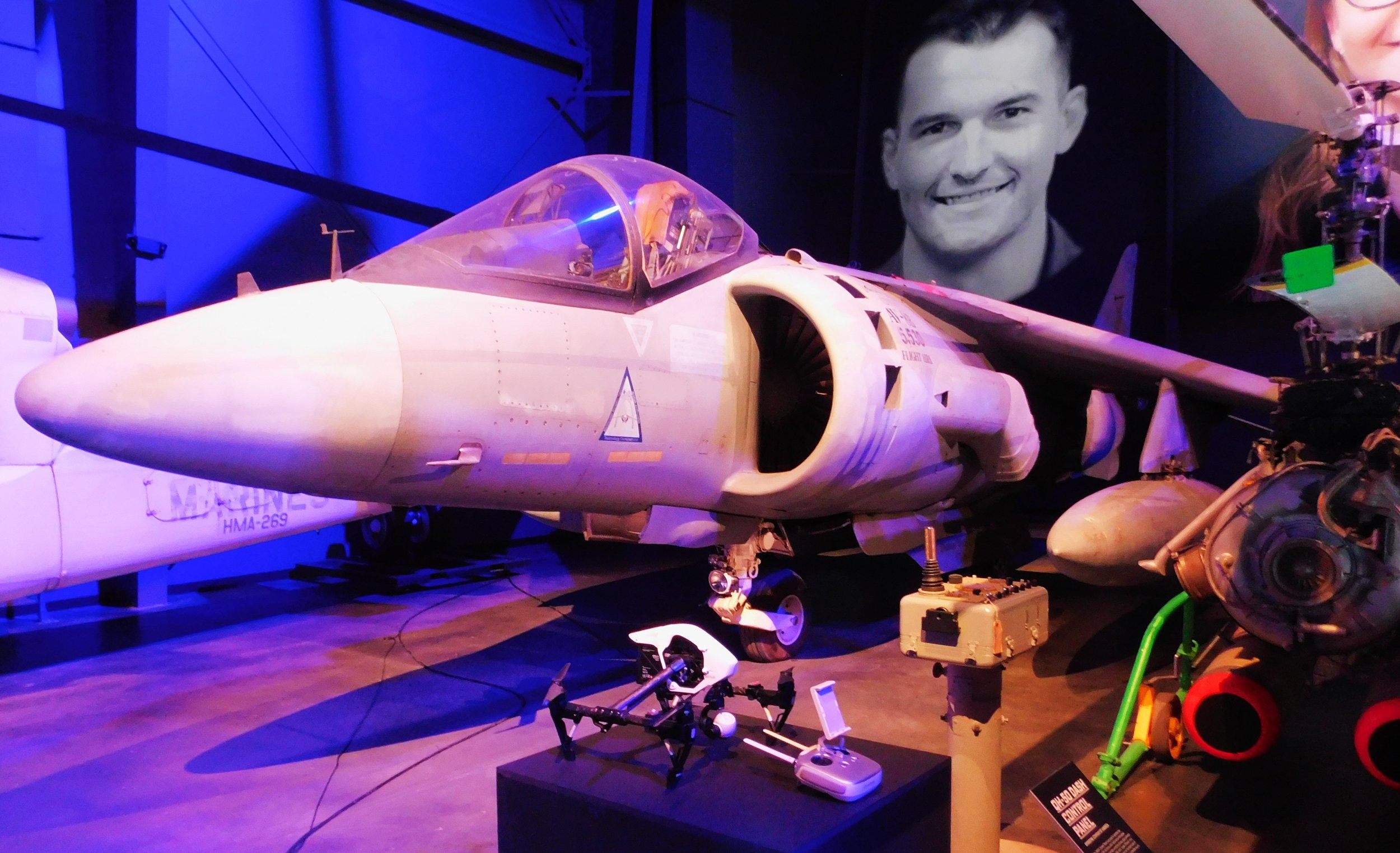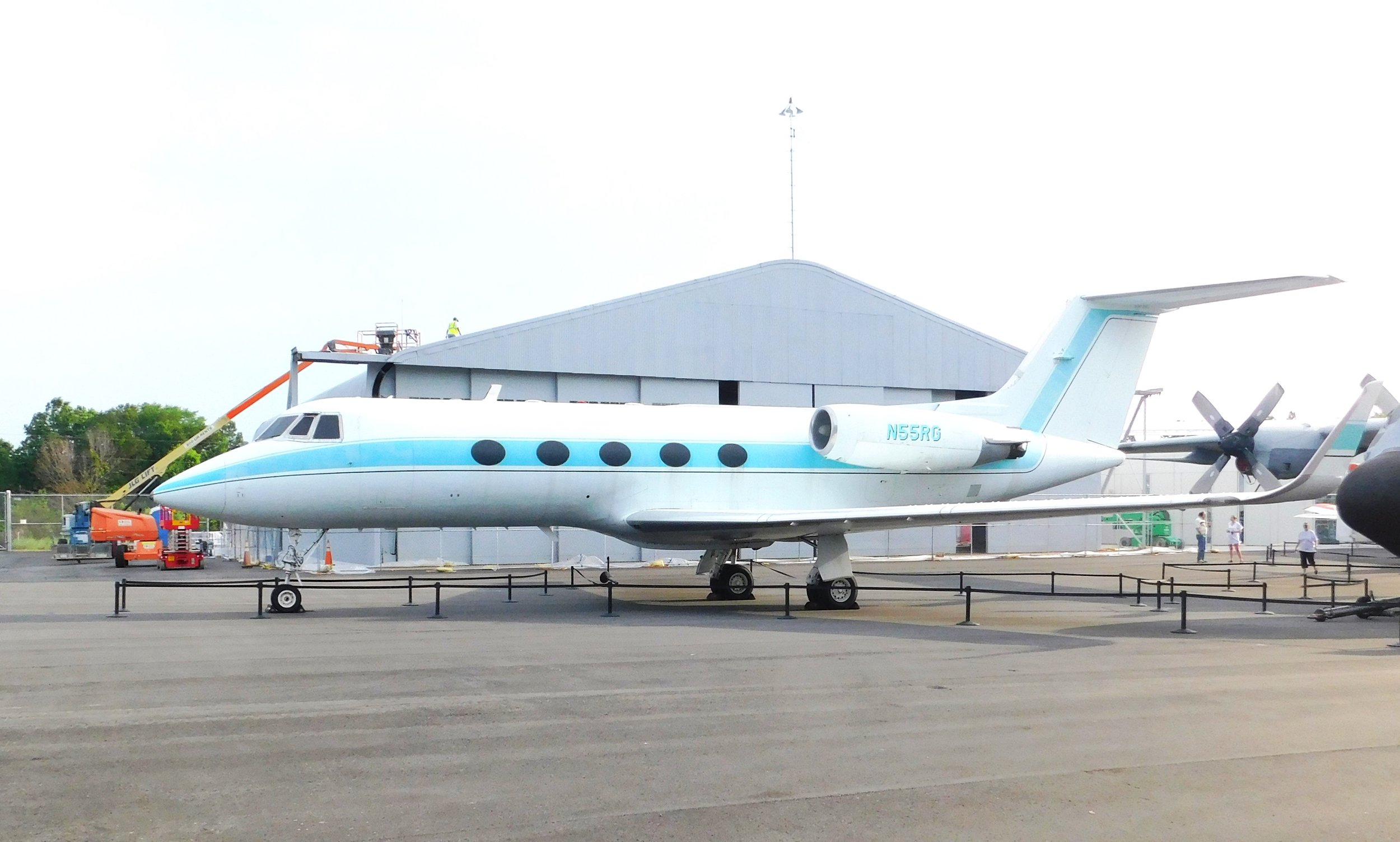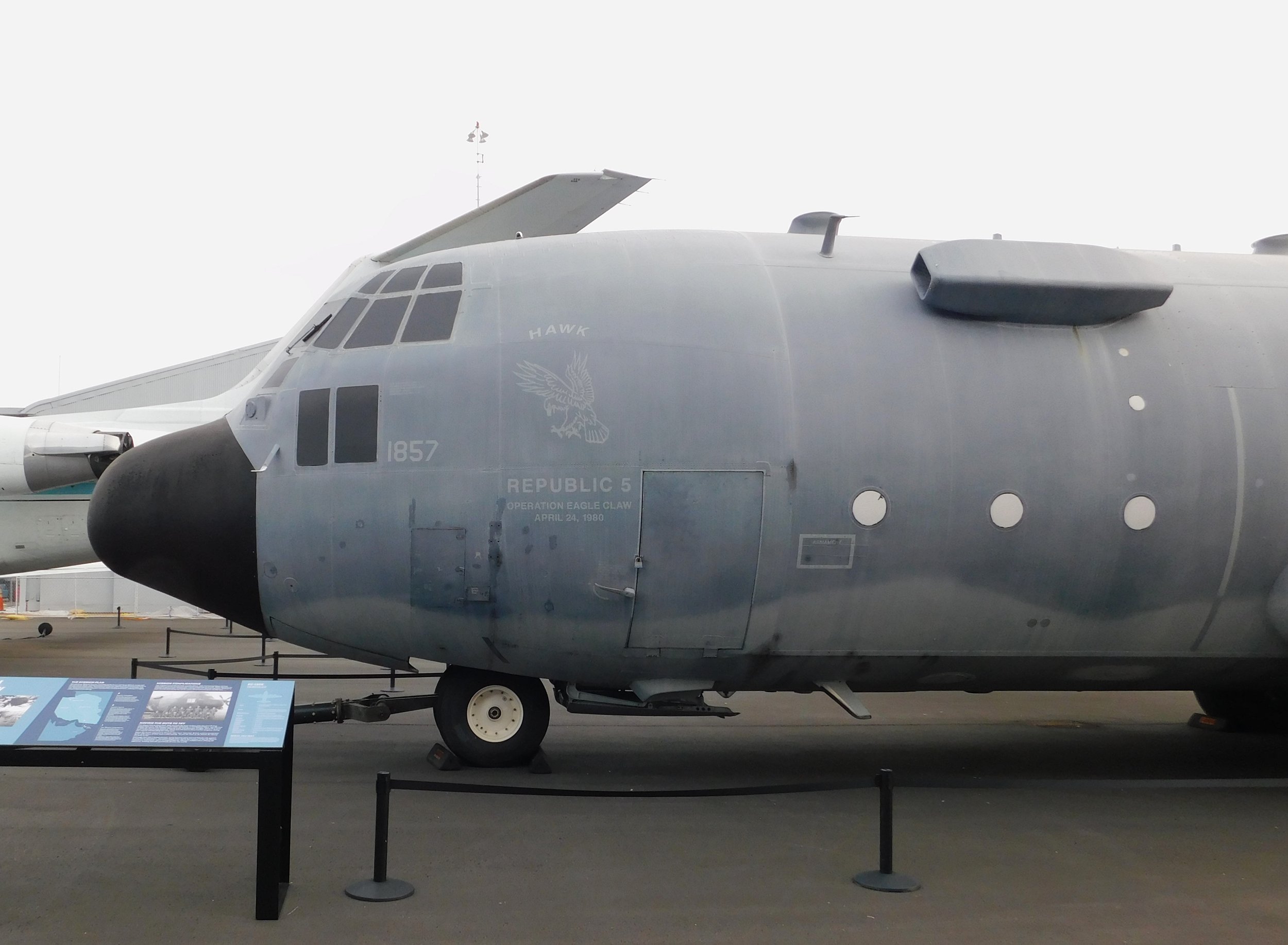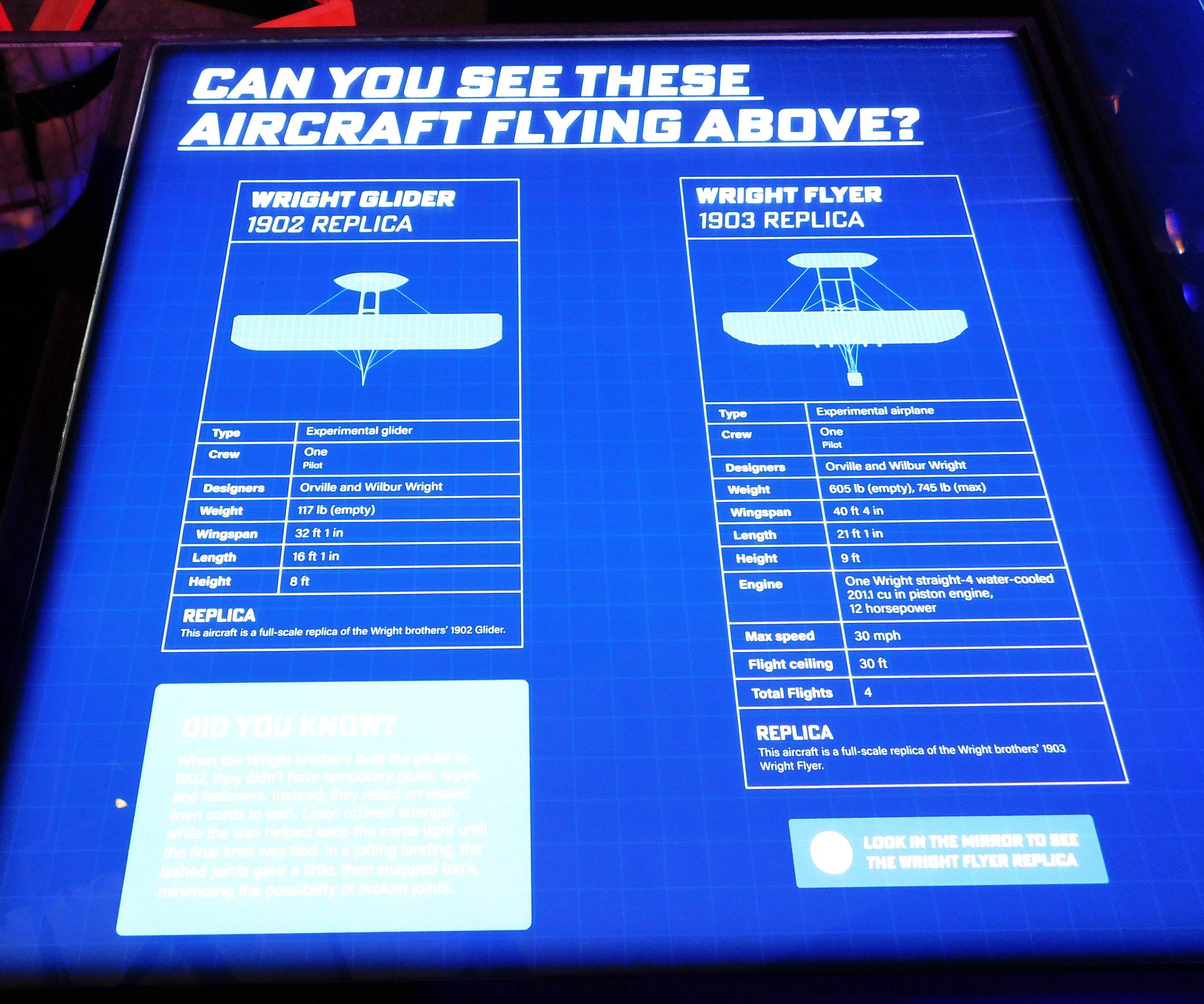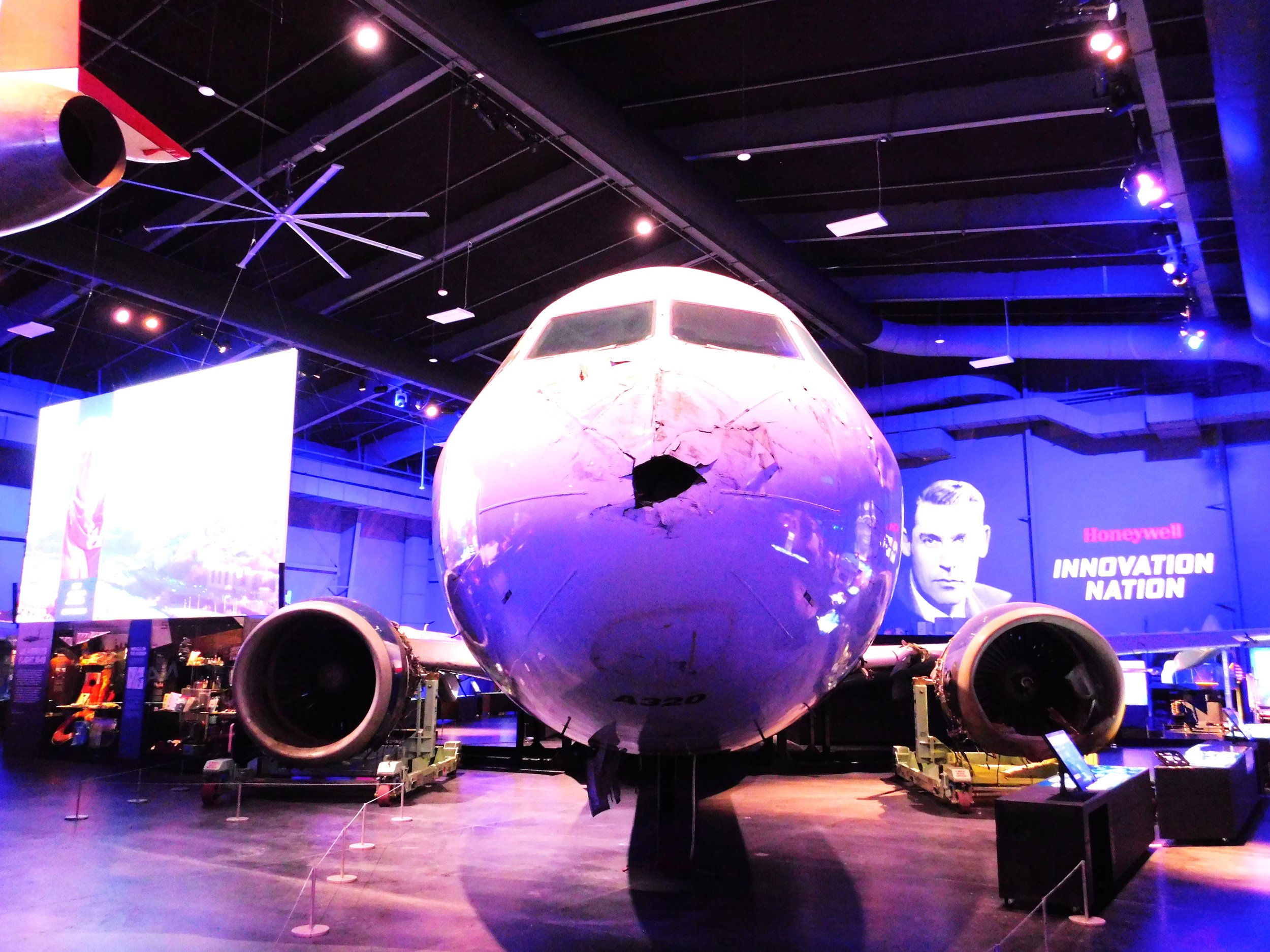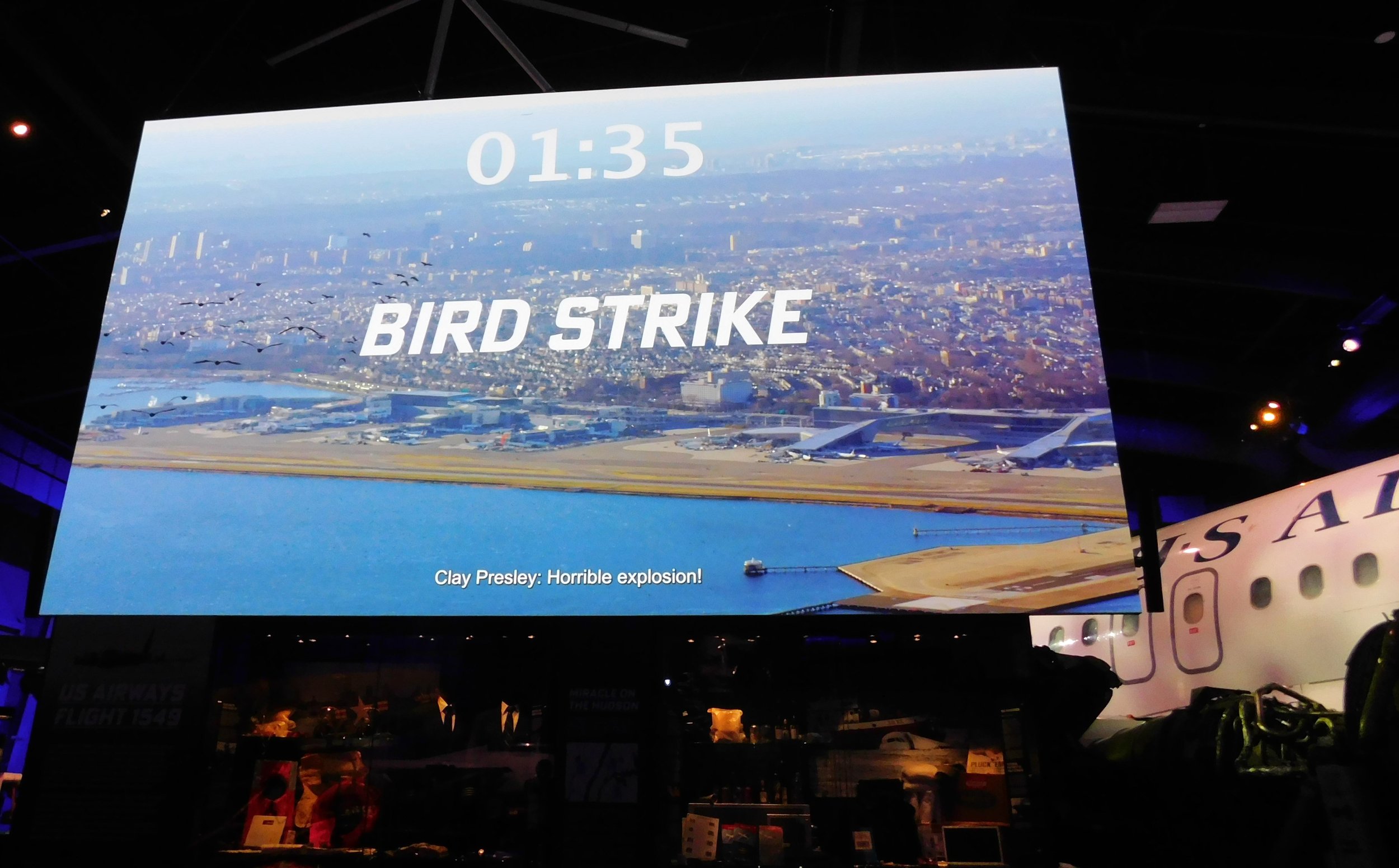Sullenberger Aviation Museum
Issue 48 A visit to Sullenberger Aviation Museum in Charlotte North Carolina September 2024
January 15, 2009 was a rather quiet winter’s day, with no significant weather on the East Coast of the US. La Guardia airport was not exceptionally busy and departure delays were minimal. US Airways flight 1549, an Airbus A-320, bound for Charlotte North Carolina, was cleared for takeoff on La Guardia’s runway 4 at 3:24 PM. The takeoff and first moments of the climb were totally normal. All of a sudden, a flock of geese appeared at 12 o’clock. The rest of the story of “The Miracle on the Hudson” is well known through news accounts and the movie Sully, starring Tom Hanks as Captain Chesley "Sully" Sullenberger. Both Sully and First Officer Jeff Skiles are now also well known. The entire Airbus A-320 from flight 1549, including engines, is on display in the newly opened Sullenberger Aviation Museum in Charlotte North Carolina.
------------------------------------------------------------
There has been an aviation Museum on the Charlotte Douglas Airport since 1992. It was originally called Carolinas Aviation Museum and was located in the airport’s original 1936-37 hangar. The hangar itself is historically significant as it was built by the depression era Works Progress Administration (WPA). The Museum went through several iterations over the years and it was closed completely in 2018 to make way for an entirely new building. The grand re-opening, with a new name- Sullenberger Aviation Museum (SAM), took place on June 1, 2024.
The original Museum had a variety of aircraft on display but it was centered around cold-war military aircraft. Although SAM now includes a wide range of historic aircraft, with the A-320 as the centerpiece, the heart of the collection remains the cold-war military aircraft.
It would be difficult to find a more important aircraft from the cold-war era than the McDonnell-Douglas F-4 Phantom II. Produced from 1958 to 1981 with a total of 5,195 built, the F-4 is the most produced supersonic fighter in US military history.
I sometimes mention how well a museum has described their aircraft on accompanying placards and other materials. The information museums provide runs the gamut from literally no information to very extensive coverage. Sullenberger Aviation Museum sits at the very top of that list – providing an amazing depth of information about each aircraft on display. SAM also lists the heritage of each aircraft – an interesting and important attribute of any aircraft on display. The information that accompanies this F-4, BuNo 155842, is a good example. The placards are wide ranging, illustrating the flexibility of the Phantom II airframe. Here is just a small sample of the information that accompanies this Phantom II.
The placards illustrate the wide range of missions that the F-4 was used for. Originally designed as a Navy all-weather fighter-bomber, the F-4 first flew in 1958. The Air Force conducted a fly-off between the F-4 and the F-106 in 1962 resulting in the acquisition of the F-4 for an air-to-air, and an air-to-ground, fighter-bomber role. The F-106, of course, also served an important role as a high-speed interceptor.
The Lockheed P-80 Shooting Star was the first USAAF jet fighter to be operational during WWII. Created by Clarence “Kelly” Johnson of Lockheed’s Skunk Works, the P-80 was first flown in 1944 and was on line in just 143 days. Lack of a supply of the British Goblin engines meant that it never saw combat in WWII. The Navy opted for the Shooting Star in 1948 when three aircraft were ordered, one equipped with a tailhook. These three were given a Navy serial number but not a Navy designation. Later in 1948, the Navy ordered 50 F-80Cs to be used as advanced jet trainers. By the Navy designation standard of the day, they were designated TO-1, the O designating Lockheed as the builder. The Navy later changed their designation for Lockheed from O to V, and the Navy version of the P-80 became the TV-1. Although short lived as a front-line fighter, the TV-1/P-80 served the Air Force, Navy, and Marines for many years as a two-seat jet trainer, the T-33. For the Navy, this trainer version was originally the TO-2, then the TV-2, and after 1962, the T-33. The Navy and Marines ordered 699 of these advanced trainers.
The museum’s TV-1, serial number 33866, was built in 1948 and used as a jet transition trainer. Retired in 1956, one of 866’s last duty stations was NAS Oakland (now San Francisco Bay Oakland International Airport), and it was given that paint scheme when it was restored in 2023.
First flown in 1953, the Convair F-102 Delta Dagger originally exhibited a number of shortcomings and a major redesign was undertaken. The wing was re-designed, along with the incorporation of the newly discovered “area rule”. The museum’s YF-102, serial number 53-1788, was one of four Convair test aircraft used to evaluate the F-102A re-design and the area rule concept. Originally formulated in Germany during WWII, the technique was further developed by NASA at Langley. Also known as the “coke bottle design”, the fuselage is pinched in the middle to reduce drag at supersonic speeds. In basic terms, the cross section of the surface area of the plane is kept as even as possible throughout the length of the aircraft- leading to a reduction in fuselage area at the wing location, and a reduction in drag.
Restored in 2024, the Delta Dagger is painted in the original Convair factory paint scheme.
Another prominent cold war fighter, the Douglas A-4 Skyhawk, was the result of a post WWII emphasis on carrier operations for advancing Naval power. The Navy was looking for a compact, carrier based, aircraft with nuclear capability and Douglas responded with the A-4. The Skyhawk was to serve the Navy and Marines for many decades. Douglas produced over 2,900 A-4s from 1954 to 1979.
This A-4, BuNo 142226, served with both Navy and Marine Corps reserve units. It is an early model- the 156th built out of 2960.
With Marine Corps Air Station (MCAS) Cherry Point a fixture on the coast of North Carolina since World War II, the Hawker Siddley/McDonnell Douglas Harrier has been a common sight in the area for many years. The AV-8 Harrier II is a V/STOL aircraft with full vertical take-off and landing capability.
This Harrier, BuNo 161397, was the second US built Harrier and McDonell Douglas retained it for flight testing. It was flown for over 5,000 flight test hours and was acquired by the museum in 2005.
In the mid-1940s, the Navy teamed with the National Advisory Committee for Aeronautics (NACA- forerunner of NASA) to develop a transonic/supersonic research aircraft. The result was the Douglas D558-1 Skystreak. Three aircraft were built, with the first flying in April of 1947. The Skystreak, powered by an Allison J35-A-11 turbojet engine, could reach Mach .99 in level flight, and the program provided a large amount of useful data. Although the value of the D558 was soon overshadowed by the Bell X-1, which exceeded Mach 1 later in 1947, much transonic research data came from the three aircraft. The Skystreak on display, BuNo 37972 (NACA-142), was the third aircraft built and it flew 81 test flights between 1949 and 1953 out of Muroc Dry Lake (also known as Rogers Dry Lake, and now Edwards AFB). This is one of just two of these historic aircraft that has survived. The other is on display at the National Naval Aviation Museum, in Pensacola,
The ramp space around the museum has several aircraft on display including this North American T-28 Trojan. The T-28 served the Navy as a basic prop trainer for many years, mainly at NAS Whiting in Milton Florida. Powered by a 1200 HP Wright Cyclone engine, the T-28 could be quite a handful for student pilots with less than 50 hours under their belt. Nonetheless, Navy Flight training in the T-28 was successful for many years. Prop students also made their first carrier landings in the T-28 (C-model), a major accomplishment that was flown solo.
This T-28B, BuNo 138285, spent most of its life at Whiting but at the end of its career it was used by the Army as a photo chase plane at Fort Bragg NC. Although retaining the Naval Air Training Command white and orange paint scheme, it also displays the Army logo.
In the 1940s and 1950s, Grumman had been very successful selling their range of seaplanes (Wigeon, Goose, Mallard, and Albatross) as corporate aircraft. In the mid-50s they determined that they would need to produce a turboprop powered executive transport. Grumman considered adding turboprops to their Widgeon or C-1 Trader. Neither plane would have been large enough and so they made a clean-sheet design which they called the Gulfstream I. The low-wing, Rolls Royce Dart powered, turboprop could seat 10-24 passengers and 200 were built between 1959 and 1969.
Grumman Gulfstream I Photo Courtesy of aircraftrecognitionguide.com
By the mid-60s, jet powered corporate aircraft, like the Sabreliner and Falcon 20, were coming on line and Grumman began design of the G-II. The large cabin and uniquely styled large windows of the G-I were retained, resulting in a top-of-the-line corporate jet. The G-II was Rolls Royce Spey powered and had a range of around 3,000 miles. Other corporate jets of the day had to stop once, maybe twice, flying coast-to-coast. while the G-II could fly NY-LA non-stop (most of the time).
When I got off active duty in 1976, there were very few airline jobs available and I got a corporate job flying Falcons and a King Air for AT&T. In 1977 we took delivery of a brand new G-II. It was the top-of-the-line corporate plane and great fun to fly. It had a few modern features like Omega/VLF navigation, but it was basically an old-school jet- lots of noise, lots of black exhaust smoke, and lots of (cheap) jet fuel burned. It was a blast to fly- and queen of the ramp wherever you went.
Grumman originally built Gulfstreams at their Bethpage, Long Island facility but, in 1966, they opened a new factory in Savannah, GA. All Gulfstreams have been built there since. Grumman sold Gulfstream in 1978 and it has had a series of owners, including Chrysler. Today it is a division of General Dynamics.
This aircraft is one more of the significant planes in the Museum collection, it is serial number 001, the first G-II built.
Also on display on the ramp is this Air Force EC-130E
In February 1979, there occurred the first stage of the revolution in Iran and the US Embassy in Tehran was briefly occupied by revolutionary forces. After months of negotiating, the Embassy was totally taken over and the US Ambassador and more than 60 other US citizens were taken hostage. The crisis was to last for 444 days.
Two days after the hostages were taken, rescue planning was put into motion. In April of 1980, President Jimmy Carter authorized a rescue attempt – named Operation Eagle Claw. The plan involved a joint mission of Army, Navy, Air Force, and Marine forces. The concept was that eight CH-53 helicopters and six C-130 aircraft would rendezvous on a salt flat (code-named Desert One) 200 miles southeast of Tehran. The helicopters would refuel from the C-130s and pick up combat troops who were also flown in on the C-130s. The helicopters would then transport the troops to a mountain location closer to Tehran (Desert Two), from which the rescue raid would be launched. No troops reached Desert Two and the mission was a disastrous failure.
The long distances involved, lack of clear command authority, and the desert winds and sand, all proved too challenging. The result was the loss of seven helicopters, one C-130 (in a collision with one of the helicopters), and eight US servicemen. The only portion of the operation that went close to plan was the arrival of the Air Force C-130s at Desert One with the troops and supplies.
This EC-130E, serial number 62-1857, participated in that ill-fated mission, with call sign Republic 5. After the mission was aborted, Republic 5 was the first C-130 to depart Desert One but, due to darkness, blowing sand, and distraction from the C-130 and CH-53, which were on fire, Republic 5 hit a sand dune on takeoff, damaging an engine and a wing-spar.
The C-130 got airborne but, because of the damage, Republic 5 was the last plane to clear Iranian airspace.
As with any failed mission, you always hope for lessons learned that lead to positive changes. This failure led to the creation of the US Special Operations Command, which is now responsible for joint military operations worldwide. It also led to the formation of Special Forces units.
Ordered as a C-130E in 1962, this plane was later converted to an Airborne Battle and Command & Control Center (ABCCC), and designated an EC-130E. This Lockheed Hercules remained in service until 2013, a total of fifty years.
There are also several helicopters on the ramp beside the Museum, including this Sikorsky CH-34 Choctaw. First flown in 1954, the H-34 was originally designed as an anti-submarine helicopter, but it soon showed its usefulness for a wide variety of missions, including as Marine One. It was so versatile and successful that it was produced through 1970, with over 2,300 built.
The H-34 was in wide use in the early 1970s, when I was on active duty, and I always marveled at the engineering involved. The H-34 was powered by a Wright R-1820, essentially the same engine that powered the C-1A that I was flying (and the B-17, among others). With this large and powerful radial engine tucked in the nose, on an angle, it was hard to imagine how it all worked together and stayed together. But it did. Very successfully.
Embracing their location on the very busy Charlotte Douglas Airport, the Museum ramp has an airport viewing area with more of the excellent descriptive placards.
SAM has other aircraft planned for display, including an ex-Eastern Airlines Douglas DC-7B and a straight-wing F-84. A few of these aircraft can be seen on a distant ramp. Some of them will be displayed in the original 1936-37 hangar after it is restored.
Throughout the museum you will see areas like this- designed to inspire aviation professionals of the future. The Museum’s mission is to inspire, educate, and elevate, a goal that is clearly met- for visitors of all ages.
With so many interesting aircraft to write about, I have not focused on any of the various other displays of aviation personalities and artifacts. Be assured that there are many great, well described, displays to view. Here are just a few examples.
No aviation museum in North Carolina would be complete without a mention of the Wright Brothers. Sullenberger Aviation Museum has two full-scale replicas on display- one of the 1902 glider and one of the 1903 Wright Flyer- each very important craft in the development of aviation.
As with the rest of the Museum, the accompanying placards are clear and informative.
———————————————————————————-
I wasn’t sure what to expect from a Museum that is so directly associated with one aircraft and one event. After visiting, my overall impression is that, although the Airbus A-320 and the story of “The Miracle on the Hudson” are clearly central to Sullenberger Aviation Museum, the curators have done an excellent job incorporating that story into a wider view of aviation history. The large aircraft and dramatic story do not overwhelm or detract from the many other interesting aircraft and displays. The fuselage and engines are displayed pretty much in the condition they were in after being recovered from the Hudson River.
The highlight of the “Miracle on the Hudson” display is a video presentation about the event. Using cockpit voice recorder transcripts, interviews with passengers and crew, and Air Traffic Control transcripts, the Museum has produced an excellent and very moving account, in real time, of the event. I asked how I could share a link to the video, but the Museum is not sharing it anywhere- the only way to see the video is in person. That makes a lot of sense. You only get the full effect with the actual plane sitting right in front of you. I have always considered this blog to have as a mission to inspire readers to visit the museums I write about. This is the ultimate example- you really have to be there!
Here are a few stills from the excellent video.
During my years of visiting museums and writing this blog, I have pointed out four planes on display that I have flown. This A-320 makes the fifth. As a US Airways A-320 Captain, 2000-2004, I flew N-106US several times.
Needless to say, Sullenberger Aviation Museum is an amazing new addition to the preservation of aviation history in the US and a Museum that needs to be on every ‘must visit’ list.
My friend Doug Campbell and I were privileged to visit Sullenberger Aviation Museum several days before the official opening. We would like to thank Stephen Saucier, Robert Touchstone, Michelle Houck, Katie Swaringen, Molly Kinyon and all the other members of the Museum staff who graciously gave us a personal tour and who helped with questions as I wrote this blog.
-------------------------------------------------------
To learn about museum hours and costs as well as books to read and other interesting odds and ends, keep reading! At the end you will find a photo gallery of the entire museum.
PLANNING YOUR VISIT
HOURS:
Tuesday - Saturday:
10:00 am - 4:30 pm
Sunday:
12:00 pm - 4:30 pm
Monday:
Closed
Holiday Schedule:
The museum is open year-round except for holiday closures on New Year’s Day, Thanksgiving Day, and Christmas Day.
ADMISSION
Adults (18+): $24 Seniors (65+): $20
Children (5-17): $18 Children under 5:Free
Military/Veterans/Educators: $20
FLYING IN
The FBO for Charlotte Douglas (CLT) is Wilson Air, located east of runway 18L. They would likely have a crew car- or would offer a ride to the museum.
MUSEUM WEBSITE
https://www.sullenbergeraviation.org
SUGGESTED READING
“All I have learned, I learned from books.” Abraham Lincoln.
The Mighty Moo (2024), by Nathan Canestard, tells the story of the WWII carrier, The USS Cowpens. Here’s the description from the Amazon listing: “The USS Cowpens and her crew weren’t your typical heroes. She was a flattop that the US Navy initially didn’t want, with a captain nearly scapegoated for the loss of his last command, pilots who self-trained on the planes they would fly into combat, and sailors that had been in uniform barely longer than the ship had been afloat. Despite their humble origins, Cowpens and her band of second-string reservists and citizen sailors served with distinction, fighting in nearly every major carrier operation from 1943 to 1945, including the Battles of the Philippine Sea and Leyte Gulf. Together they faced a deadly typhoon that brought the ship to the verge of capsizing, and at war’s end there was only one US aircraft carrier in Tokyo Bay to witness the Japanese surrender”
Thanks to my brother Mike for this recommendation.
Aircraft Recognition Guide (that provided the G-I photograph) is a pretty cool website- with lots of information. https://www.aircraftrecognitionguide.com/
WRIGHT BROTHERS STORIES
While writing this blog, I was also preparing a presentation that I gave at the Wright Brothers Memorial on August 19th- National Aviation Day.
President Franklin Roosevelt designated August 19th as National Aviation Day in 1939 in honor of Orville Wright’s birthday, and that day has been celebrated every year since. Most historians agree that the invention of the airplane was a collaboration between Wilbur and Orville, and probably would not have happened without both men. You usually have to dig deeper into the history books to find a recognition of the contribution of their younger sister, Katharine, to their work. August 19th was also the birthday of Katharine and there has been a movement in recent years to also celebrate the contributions of Katharine to the work of The Wright Brothers. In 2023, the North Carolina legislature entered a proclamation declaring National Aviation Day a celebration of Orville and Katharine Wright.
The Wright brothers’ mother, Susan, died in 1889 and from that point on, Katharine (although only 11 at the time) more and more became the glue that held the family together. Their father, the Reverend Wright, was often away travelling and Katharine kept a strong homestead in Dayton for the family. As Wilbur and Orville delved more into their quest for flight, Katharine became their organizing force. In many ways, she was also a crucial contributor to the conquest of flight.
UP NEXT
Cotswold Airport in the West of England.
MUSEUMS ARE WHERE YOU FIND THEM
This segment is dedicated to finding interesting aviation artifacts that are in public view- but not in an aviation museum. If you see one send a photo!
Photo, Doug Campbell
Sullenberger Aviation Museum is on the northeast side of Charlotte Airport, in between runway 18L and the old 23. To drive there, you pass by the North Carolina Air Guard base, with a North American F-86 posed as a gate guard. This F-86L serial number 52-4142, was built in 1951 and served in a flight-testing role both with the National Advisory Committee for Aeronautics (NACA) and North American Aviation.
PHOTO GALLERY
click any photo to enlarge
Issue 48, Copyright©2024, Pilot House Publishing, LLC. All rights reserved.
Except where noted, all photos by the author








